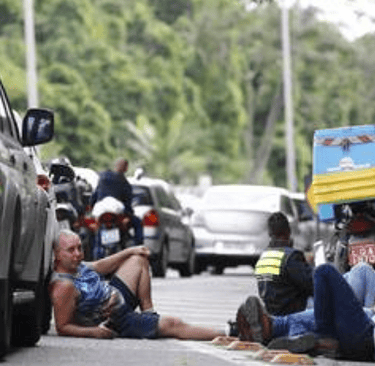From Yellow Line to Bloodline
From Yellow Line to Bloodline: Rio de Janeiro's Road Solution Turned Violence Hotspot. The Yellow Line, inaugurated in 1997, was designed to alleviate Rio de Janeiro's chaotic traffic, connecting the North Zone to Barra da Tijuca.
FACES AND FACTS
Everton Faustino
4/24/20254 min read


Citizens in Rio de Janeiro crouch down to shield themselves from gunfire.
The Necessity of the Yellow Line
Inaugurated in 1997, Rio de Janeiro's Linha Amarela (Yellow Line) was envisioned as a crucial solution to alleviate the city's notorious traffic congestion, directly connecting the North Zone to the upscale Barra da Tijuca district. This over 20-kilometer express highway promised to slash commute times and spur urban development. However, over the years, this promise of progress has been tragically overshadowed by a brutal reality: escalating violence.
The name Linha Amarela is part of a polychromatic urban planning project from the 1960s by Greek urbanist Constantínos Apóstolos Doxiádis, commissioned by the then-Governor of Guanabara State, Carlos Lacerda. The original blueprint included several expressways, each identified by a different color, to streamline urban mobility in Rio de Janeiro.
Interestingly, the Yellow Line was initially conceived as a subway line linking the Méier neighborhood to Barra da Tijuca but ultimately became a vital road expressway. The choice of the color yellow aligned with the project's logic, which also included the Linha Vermelha (Red Line), another significant expressway in the city.
The Linha Amarela remains one of Rio de Janeiro's busiest expressways, handling an estimated daily flow of 150,000 vehicles. For many neighborhoods in the North Zone, such as Méier, Engenho de Dentro, Del Castilho, and Jacarepaguá, the highway is essential, representing the only viable alternative to access areas like Barra da Tijuca without facing severe congestion on other routes. This dependence on the Yellow Line makes the issue of safety even more critical, as thousands of drivers and passengers are forced to travel through an area frequently plagued by urban violence.
Construction and Controversy
The construction of the Linha Amarela had an estimated cost of R$ 400 million and took approximately three years to complete, from 1994 to 1997. The project was divided into three sections, with the second being the most challenging, requiring the drilling of the Serra dos Pretos-Forros massif to build the Covanca Tunnel, one of the world's largest urban tunnels.
However, the return on investment is a contentious issue. Initially, the highway brought significant benefits to urban mobility, reducing travel time between the North Zone and Barra da Tijuca. Yet, with the passage of years, the increasing violence in the region has compromised its functionality. The constant fear of shootings and robberies has led many drivers to avoid the route, diminishing its effectiveness as a traffic solution. Furthermore, the concession of the Linha Amarela has been the subject of legal disputes, with allegations of overpricing in construction and questions about the highway's management.
Transformation into a Conflict Zone
What was intended to be a mobility corridor has become one of the most dangerous points in the city. The Linha Amarela cuts through areas dominated by criminal factions, frequently becoming a stage for exchanges of gunfire between police and drug traffickers. The proximity to communities controlled by organized crime means the highway is often used as an escape route and territory for ambushes.
The violence on the Linha Amarela is not limited to confrontations between police and criminals. Robberies of drivers, express kidnappings, and shootings in broad daylight are recurring events. In many cases, innocent citizens are injured or killed, victims of crossfire.
Tragically, the Linha Amarela records an alarming average of 25 deaths per year due to shootings and armed conflicts, according to recent data that includes other expressways in Rio. This statistic reflects the severity of the violence in the region and the direct impact on the safety of citizens who depend on this route for their daily commutes.
Why Are Confrontations Constant?
The heavy police presence on the Linha Amarela aims to contain criminal activity but also intensifies conflicts. Factions vying for territorial control of nearby communities see the highway as a strategic point. When the police intervene, criminals react violently, resulting in shootouts that endanger the lives of those passing through.
Furthermore, the Linha Amarela is frequently used for vehicle theft, leading to police chases and armed confrontations. The lack of security and impunity contribute to the perpetuation of this cycle of violence.
Alert to Tourists: Navigating Rio de Janeiro Safely
For international tourists arriving in Rio de Janeiro, the Linha Amarela poses a significant risk, especially for those unfamiliar with the city's security dynamics. The highway traverses conflict zones where shootouts between criminal factions and police forces are frequent, making the journey unpredictable and potentially dangerous. Many visitors landing at Galeão International Airport need to cross the Linha Amarela to reach the South Zone, where the main tourist attractions and hotels are located.
An alternative to avoid this risk is to opt for a flight to Guarulhos (São Paulo) and then a domestic flight to Santos Dumont Airport, located in the heart of Rio de Janeiro. This route eliminates the need to travel through high-risk areas and offers a more direct arrival to the tourist region of the city. However, this option may increase travel time and costs, as it involves an additional flight connection. For safety-conscious tourists, this alternative may be worthwhile, especially for those who prefer to minimize any exposure to urban conflict zones.
From Road Solution to Risk for the Population
The paradox of the Linha Amarela is stark: a road created to improve urban mobility has transformed into one of the greatest risks for the residents of Rio. The state's inability to guarantee security in the region reflects a broader structural problem, where organized crime dictates the rules and the population lives under constant threat.
The solution to this scenario requires more than just policing. An integrated public safety plan, investments in infrastructure, and social policies that reduce the influence of drug trafficking in nearby communities are essential. Without these measures, the Linha Amarela will continue to be a symbol of the state's failure in the fight against urban violence.
The lingering question is: how long will the people of Rio have to live with fear on a road that was meant to represent progress?
TAGS: Rio de Janeiro, Yellow Line, Linha Amarela, Brazil, violence, crime, traffic, urban development, safety, tourism, airport, conflict zone.
Research:
https://g1.globo.com/rj/rio-de-janeiro/noticia/2024/11/27/tiros-na-linha-amarela.ghtml
https://ecoserrano.com.br/policia/ao-vivo-confronto-entre-policia-e-bandidos-deixa-motociclista-ferido-no-rio-de-janeiro/
https://www.cnnbrasil.com.br/nacional/rj-suspeito-ferido-em-tiroteio-na-linha-amarela-cumpriu-pena-por-trafico-de-drogas-diz-tj/
https://pt.wikipedia.org/wiki/Linha_Amarela_%28Rio_de_Janeiro%29
https://diariodorio.com/a-historia-da-linha-amarela-de-projeto-visionario-a-disputas-legais/
https://g1.globo.com/rj/rio-de-janeiro/noticia/2022/09/27/prefeitura-do-rio-decide-cassar-a-concessao-da-linha-amarela.ghtml
https://www.cnnbrasil.com.br/nacional/mais-de-50-pessoas-foram-baleadas-em-vias-expressas-do-rio-nos-ultimos-tres-anos/
https://www.travelsafe-abroad.com/br/brasil/rio-de-janeiro/
https://www.viajenaviagem.com/destino/rio-de-janeiro/seguranca/
The Yellow Line - Soul do Rio.
